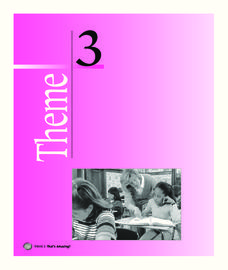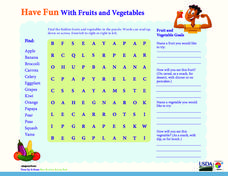Curated OER
Food for Thought
Fifth graders explore the brain and what is needs. In this biology lesson plan, 5th graders will work on a series of activities that will allow them to learn about the brain, its parts, and the best foods to eat for their brain.
Curated OER
"Four" Goodness Sake
Fourth graders recognize that ethnicity, religion and geography are reflected in the food choices we make. In this food choices lesson, 4th graders discuss different types of food from different places. Students compare a menu to the...
Curated OER
The Science and Technology of Food
Students examine the guidelines the United States Department of Agriculture places on food. In groups, they create a list of the foods they consume and discuss the political and environmental implications of purchasing the food. They...
Curated OER
Sondage: J'ai horreur des broccolis! A Survey of Food Preferences: I Hate Broccoli!
Students participate in contrived conversation in French to determine preferences for known food items.
Curated OER
Food in Our Lives
Young scholars examine the food pyramid. In this healthy eating lesson, students discover the parts of the food pyramid and how much to eat from each section. They cut out pictures to glue on their food pyramid.
Houghton Mifflin Harcourt
That’s Amazing!: English Language Development Lessons (Theme 3)
That's Amazing! is the theme of an English language development unit created by Houghton Mifflin. Following a speak, look, move, and listen routine, scholars delve into topics; seasons, weather, animals, landforms, telling time,...
Choose My Plate
MyPlate Word Search
Encourage healthy eating, cooking, and goal setting with a word search that showcases a variety of fruits and vegetables, and provides a four-step plan to eat more of them.
Curated OER
Water Pollution and Food Chains
Sixth graders study the effect of pollution in our food chains. In this plant biology lesson, 6th graders first experiment with pollution by placing a carnation in colored water. Next they use a food chain triangle to see the concept of...
Curated OER
Using the Food Pyramid to Make Healthy Food Choices
Students investigate how to make healthy choices. In this food pyramid lesson, students read about making healthy choices. Students chart the food they eat to see where it is on the pyramid. Students then create a collage of healthy...
Curated OER
redator and Prey- Food chain relationships
Young scholars s identify the different trophic levels in the food chain and understand the importance of the energy cycle. They create a class food web using index cards and yarn and play a predator/prey game.
Curated OER
Marine Ecosystems
Young scholars identify producers and consumers and construct a food chain from four marine ecosystems. They describe the delicate balance among organisms in each environment. In groups, students discuss the human activities that upset...
Curated OER
Week 8 - Sea Life
Using a magnifier, mini marine biologists examine the barbules of a bird feather. They swirl the it into a mixture of oil and water and then re-examine the feather. After the activity, discuss how the oily feathers pose a problem to sea...
Teach Engineering
Investigating the Properties of Plastic and its Effects on the Environment
Pore over the properties of plastic. Working through four different stations, pupils investigate some properties of plastic, including chemical decomposition, mechanical breakdown, density, and the ability to infiltrate the food chain....
National Wildlife Federation
Soil Decomposers
Worms are the kings of the decomposers. A four-part lesson has learners experiment with the characteristics of earthworms and their sensitivities. They vary factors such as light, acidity, temperature, and touch of soil and observe the...
Curated OER
Food Sources
Students develop a working vocabulary of food by categorizing foods by their sources or origins. Working in groups, they determine at least four ways in which food is grown or produced. Groups create a poster by diving selected food...
Curated OER
Healthy Choice Shopping Frenzy
Pupils learn the categories of the food pyramid. In this food groups lesson, students learn to categorize food. Through this activity pupils scoot to different food groups learning about the foods that belong in each group.
National Park Service
Fitting In
Birds help other birds find food? Scholars are placed into one of five groups of different birds. Each group then "feeds" on letters of paper in a field and gather five pieces per person. As each group plays, more food is exposed,...
Nemours KidsHealth
Media Literacy and Health: Grades 9-12
An essential skill for 21st-century learners is to know how to find reliable sources of information. Two activities help high schoolers learn how to determine the reliability of health-related news from websites, TV, magazines, or...
Worchester Polytechnic Institute
Interactive Laboratory Activities for Secondary Education
Do you think the lab smells like rotten eggs? Sorry to hear about your sulfering. A set of five experiments covers many different topics including seasons, gravity, food, precipitation, and photosynthesis. Though not presented as a...
Curated OER
Healthy Choice Shopping Frenzy
Students identify the four food groups. For this food pyramid lesson. students use pictures of food to determine what food group they belong to. Foods that are placed in the wrong place are discussed.
Curated OER
What’s the Shape of Your Diet?
Students analyze their diets. In this healthy diet activity, students keep food journals and examine their diets next to the recommended daily allowances of MyPyramid for Kids.
Curated OER
Pond Water Web
Learners identify the different organisms in the food web. In this biology lesson, students create food chains using the information on cards. They explain what happens if an organism is removed or added in the web.
Curated OER
Soul Food
Students identify foods that they associate with different cultural groups in which they are members and speculate possible connections between specific foods and the cultures in which they are popular. They also explore the importance...
Curated OER
Classification
Students investigate how different types of food can be classified then counted. In this sorting, arranging, and classifying lesson plan, students explore how to group foods based on commonalities. Students are asked four questions which...

























